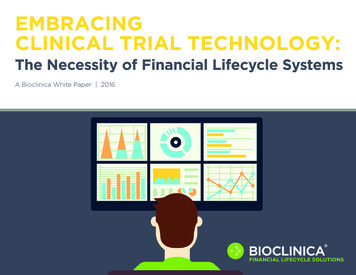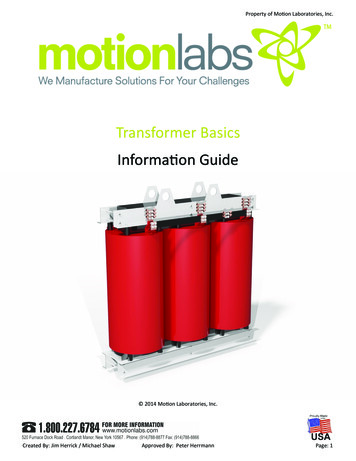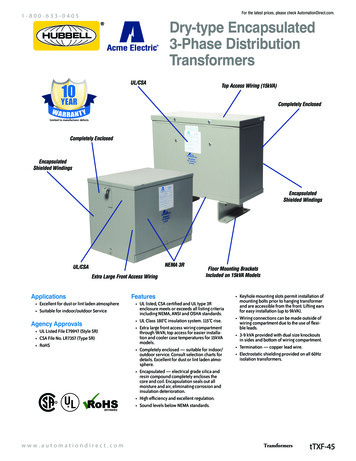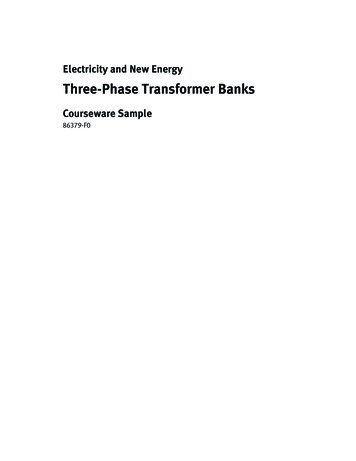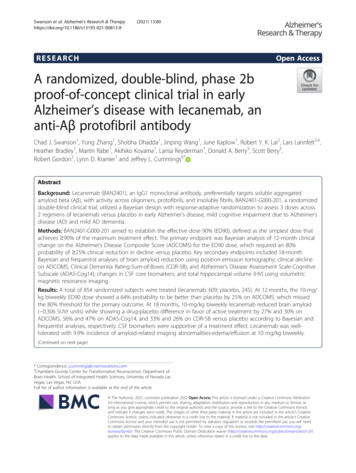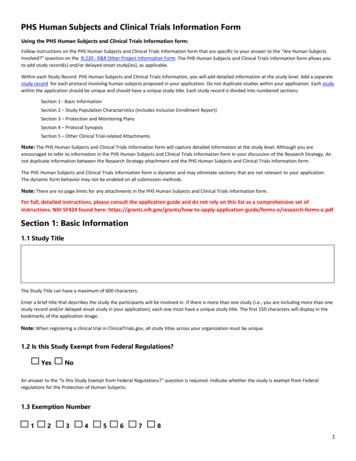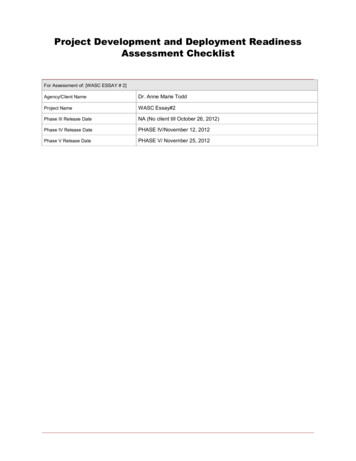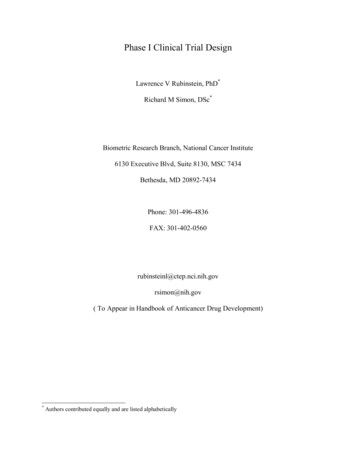
Transcription
Phase I Clinical Trial DesignLawrence V Rubinstein, PhD*Richard M Simon, DSc*Biometric Research Branch, National Cancer Institute6130 Executive Blvd, Suite 8130, MSC 7434Bethesda, MD 20892-7434Phone: 301-496-4836FAX: .gov( To Appear in Handbook of Anticancer Drug Development)*Authors contributed equally and are listed alphabetically
IntroductionThe objective of a phase I trial is to determine the appropriate dosage of an agent or combination to betaken into further study and to provide initial pharmacologic and pharmacokinetic studies. It is generally assumed,at this stage of testing, that increased dose is associated with increased chance of clinical efficacy. Therefore, thephase I trial is designed as a dose-escalation study to determine the maximum tolerable dosage (MTD), that is, themaximum dose associated with an acceptable level of dose-limiting toxicity (DLT--usually defined to be grade 3 orabove toxicity, excepting grade 3 neutropenia unaccompanied by either fever or infection 35). This MTD is thentaken into further testing. Since evaluation of efficacy is generally not the objective of a phase I trial, it is notnecessary to restrict to a patient population homogeneous with respect to disease, or even to restrict to patients withmeasurable disease (for which tumor response is determinable). It is important, however, to exclude patients withimpaired organ function, who may therefore be more prone to serious toxicity. The fundamental conflict in phase Itrials is between escalating too fast, so as to expose patients to excessive toxicity, and escalating too slow, so as todeny patients the opportunity to be treated at potentially efficacious dose levels 10. Phase I trials for compounds orbiologics in which toxicity is not expected, and determination of the MTD is not the objective, will be discussedlater in this chapter.The first problem in a phase I trial is deciding on a safe, but not overly conservative, initial dose for thetrial. If the agent is new to clinical testing, this must be based on animal studies. It has been determined that thedose (defined in mg per meters squared of body surface area) associated with 10% lethality in mice (MELD10) canbe predicted to be roughly equivalent to the human MTD 18. This approach is derived from the concept of“allometric scaling” 15, 25. Toxicity as a function of body weight or surface area is assumed to be roughly constantacross species. The initial dose for the phase I trial is taken to be 1/10 the MELD10 or, if smaller, 1/3 the LD10(associated with 10% lethality) in the beagle dog 23. The use of a second species has been shown to be necessary,since in approximately 20% of approximately 90 reviewed drugs, mouse data alone was insufficient to safely predictthe human MTD 2. American investigators generally use the dog as the second species, while Europeaninvestigators generally use the rat, with equivalent safety 2. The next problem is to define dose increments for thesubsequent dose levels, and it is here that the various phase I trial designs part company.1
Standard phase I designThe “standard” phase I design utilizes a set of decreasing “Fibonacci” dose level increments proposed bySchneiderman 32, and currently taken to be 100%, 67%, 50%, 40%, and 33% thereafter 10. These increments areadded to each dose level to give the succeeding level. In other words, the second dose level is 100% greater than thefirst, the third is 67% greater than the second, and so forth. The purpose is to allow more aggressive dose escalationfor the initial levels, which are expected to be sufficiently removed from the MTD for this to be safe. If the MELD10accurately predicted the human MTD, only 5-6 such dose escalations would be necessary to complete a “standard”phase I design. Unfortunately, this is often not the case 27.The “standard” rule governing dose escalation from one level to the next relies on no assumptionsconcerning the shape of the dose-toxicity curve or the potential for cumulative toxicity, and therefore the decision toescalate to the next dose level is based solely on toxicity results from the first course administration of the currentlevel. The dose escalation rules (Table 1) proceed as follows, escalating in cohorts of 3-6 patients per dose level 35.Three patients are treated at the current dose level. If at least 2 patients are observed to have DLT, the prior doselevel is defined as the MTD (unless only 3 patients have been treated at that level, in which case it is the tentativeMTD). If 0 of the 3 patients are observed to have DLT, the dose level is escalated one step for the next cohort of 3patients, and the process continues as above. If exactly 1 of the 3 patients treated show DLT, 3 additional patientsare treated at the current dose level. If none of these additional 3 patients show DLT, the dose level is escalated forthe next cohort of 3 patients, and the process continues as above; otherwise, the prior dose level is defined as theMTD (unless only 3 patients have been treated at that level, in which case it is the tentative MTD). A tentativeMTD becomes final when a total of 6 patients are treated with less than 2 showing DLT.The statistical operating characteristics of this approach are as follows (Table 2). If at least 2 of 3 patientstreated at a particular dose show DLT, we can conclude with 90% confidence that the true probability of DLT at thatdose is greater than 20%. (In other words, as we see in Table 2, unless the true probability of DLT at that dose is atleast 20%, the probability of at least 2 out of 3 patients exhibiting DLT is less than 10%.) On the other hand, if 0 of3 patients show DLT, we can conclude with 90% confidence that the true probability of DLT is less than 55%.(Again, as we see in Table 2, unless the true probability of DLT is less than 55%, the probability of 0 out of 3patients exhibiting DLT is less than 10%.) In the interest of efficiency, we accept either of these situations as2
sufficient to halt or continue escalation after treating only 3 patients at the current level. Allowing for expansion to6 patients in case 1 of the initial 3 show DLT, the dose escalation rule gives 91% probability that dose escalationwill not halt at doses associated with DLT probability less than 10%, and it gives 92% probability that escalationwill not proceed beyond doses associated with DLT probability in excess of 60% (Table 2). The process ofapproaching the MTD from below, in successive steps, further protects against defining an MTD associated withexcessive toxicity. Table 2 plus simulations 17, 20 show that, for a wide variety of dose-toxicity curves, theprobability is approximately 85% - 90% that the defined MTD will be associated with DLT probability ofapproximately 10% - 45%.The primary criticisms of the standard phase I design 17, 30, 35, 39 are:1) It does not target a particular probability of DLT to be associated with the MTD, and, in practice, the DLTrate associated with the defined MTD will be somewhat dependent on the DLT rates of the various doselevels.2) The MTD definition is unnecessarily imprecise in that it does not make adequate use of all the availablefirst-course toxicity data.3) The dose escalation is unnecessarily slow, leading to treatment of excessive numbers of patients at doselevels less likely to be efficacious.Storer 39 proposed defining the MTD by fitting all the first course toxicity data to a logistic dose-toxicity curve (asigmoidal curve that maps dose levels to associated DLT rates, for example, equation (1), discussed in more detailbelow) and letting the MTD be the dose level associated with the targeted DLT rate (usually, 20% - 30%), thusaddressing criticisms (1) and (2) of the standard design. To address criticism (3), he suggested escalating the dose insingle-patient cohorts until DLT is observed, at which point dose escalation would revert to the standard design.Continual Reassessment Method (CRM)O’Quigley et al. 30 extended the modeling idea of Storer 39 by proposing the use of a dose-toxicity model toguide the dose-escalation, as well as to define the MTD. First, a statistical model, such as equation (1), relating doseto probability of dose-limiting toxicity, is defined. Using a Bayesian statistical approach 24, the free parameter (α)3
of the model is initially given a “prior” probability distribution such that the model maps the dose-levels toprobabilities of dose-limiting toxicity in accord with investigator expectations. O’Quigley et al. 30 proposed thateach successive patient in the phase I trial be treated at the expected MTD, according to the current state of themodel, and that the model be immediately “updated” (that the “posterior” distribution of the free parameter be recalculated, according to Bayes’ theorem 24) by incorporating first-course toxicity data obtained from each successivepatient. They proposed that when the sample size reached a preset limit of 20-25, the MTD be calculated from thefinal state of the dose-toxicity model.Original form of CRMO’Quigley et al. 30 designated the above approach the Continual Reassessment Method (CRM). It can bemade clearer by examining use of the following one-parameter logistic model, proposed by Goodman et al. 17 fordefining the probability of DLT pi at the ith dose level, in conjunction with CRM:pi e3 a xi(1 e3 a xi)(1)By the methods of Goodman et al. 17 the investigators first define an increasing set of dose levels (indexed by i) tobe used in the phase I trial. The investigators provide initial expectations of the probabilities of DLT (the pi’s) atthose doses. The initial (“prior”) distribution of the parameter " is taken to be the standard exponential distributionwith mean and variance equal to one. The xi values are determined by equation (1) by letting " be equal to one (itsmean according to the initially given exponential distribution) and by letting the pi’s be the initial expectations ofthe investigators. (For example, Goodman et al. 17 give xi values of -5.9, -5.2, -4.3, -3.6, -3.0, and -2.15, tocorrespond to prior expectations for DLT rate pi of .05, .1, .2, .35, .5, and .7.) The substantial uncertainty of theinvestigators’ initial expectations is represented by the variability associated with the initial distribution of ". Forexample, using the above prior distribution, the dose initially associated with an expected DLT rate of 20% has a33% probability of actually being associated with a DLT rate in excess of 75%, and it has a 20% probability ofbeing associated with a DLT rate less than 5%. (In other words, the initial state of the model reflects that the4
investigators’ initial guess at an MTD could actually be either a very toxic dose, or a very non-toxic dose, both withreasonably high probability.) As each successive patient is treated, the distribution of " is re-calculated according toBayes’ theorem 24, to reflect the new toxicity data and the greater certainty associated with the dose-toxicityrelationship. Equation (1), with " having this re-calculated “posterior” distribution, eventually reflects the dosetoxicity pattern actually observed in the phase I trial, with substantially less uncertainty associated with the predictedDLT rates pi .O’Quigley et al. 29, 30 suggested fixing the sample size of a CRM-based phase I trial at 20-25 patients. Atthe termination of the trial, the MTD is defined to be the dose associated with the target DLT rate (usually 15% 25%), according to the final state of the dose-toxicity model (according to equation (1), for example, letting " be themean of its final “posterior” distribution). O’Quigley 28 gives simulations to demonstrate the accuracy of theconfidence interval for the rate of DLT at the chosen MTD (for sample size 20). O’Quigley et al. 29, 30 argued thatCRM addresses the serious concerns associated with the standard phase I design, given above. They noted that useof a dose-toxicity model allows the investigators to target a specific DLT rate to be associated with the MTD, and itallows all of the first-course toxicity to be incorporated in defining the MTD. They stressed the importance oftreating each patient at a sufficiently high dose to offer the hope of an effect, and they asserted that treating eachpatient at the currently estimated MTD avoids systematic under-treatment of patients, without involvingsignificantly increased risk of DLT (compared to the standard design), according to their simulations 29.Amendments and alterations of CRMKorn et al. 20 argued that, based on their simulations, CRM did, in fact, significantly increase the DLT riskto patients, compared to the standard design. They demonstrated that CRM tended, with substantially increasedprobability, to treat patients at doses higher than the MTD, even at doses two or more levels higher, where DLTcould be not only more frequent, but also more serious. This was seen to be a result of treating each successivepatient at the currently estimated MTD. In particular, the initial patients were to be treated thus, despite the fact thatthe initial state of the dose-toxicity model might often reflect the uncertainty of the investigators with respect to theclinical toxicity of the untested agent.5
Concerns such as these resulted in a number of proposed alterations to the original CRM. Goodman et al.17suggested that dose escalation begin at the standard initial dose (usually the MELD10), and that it proceed, at most,one dose step at a time (although they did not give guidance as to how these dose steps should be defined). Theypresented simulations to demonstrate that this approach avoided the increased DLT risk associated with the originalCRM, while preserving the advantages of greater efficiency and accuracy. Babb et al. 3 suggested that, rather thantreat patients at the dose expected to yield the targeted rate of DLT (which gives 50% likelihood of exceeding thetargeted MTD, according to the dose-toxicity model), patients should be treated at the dose associated with 25%likelihood of exceeding the MTD, according to the current state of the model. They presented simulations todemonstrate that this approach also avoided the increased DLT risk of the original CRM, while preserving efficiencyand accuracy. Finally, Potter 31 suggested, in answer to concerns about attempting to define an initial dose-toxicitymodel without clinical experience, that the initial stage of the phase I trial proceed in a standard fashion (escalatingfrom the starting dose with successive 50% dose increments), until DLT is observed. At that point, a dose-toxicitymodel would be constructed, based on the trial data only. Patients would then be treated at the currently estimatedMTD, based on the model. The trial would terminate when 18 patients had been treated, with at least 4 instances ofDLT, and with at least 9 patients treated subsequent to the initial such instance.All of the above alterations were accompanied by a retreat from single-patient cohorts, as originallysuggested by O’Quigley et al. 29, 30, to three-patient cohorts. This was prompted, in part, by the practicalconsideration relating to the usual brisk accrual to phase I trials, but also, more importantly, by the desire to achievegreater safety with the accumulation of more first-course toxicity data between successive updates of the dosetoxicity model.Accelerated Titration DesignsAccelerated titration designs attempt to improve several aspects of conventional designs. (i) With standarddesigns many patients are treated at doses well below the biologically active level, minimizing the opportunity foranti-tumor response. (ii) Many phase I trials using the standard design take a long time to complete. (iii)Conventional designs select a dose for the population of patients, and there is no attempt to tailor doses to individualpatients; (iv) Conventional designs provide little information about inter-patient variability, cumulative toxicity or6
the steepness of the dose-toxicity relationships.Accelerated titration designs are characterized by (i) A rapid initial escalation phase; (ii) Intra-patient doseescalation; and (iii) Analysis of results using a model that incorporates parameters for intra-patient variation in toxiceffects, cumulative toxicity and steepness of dose-toxicity effects. The analytic model incorporates data from allcourses of therapy and for graded toxicity levels.Rapid Acceleration PhaseSimon et al. 35 defined several accelerated titration designs and compared them to a standard design (calleddesign 1). Design 1 differs from the standard phase I design described above only in that Simon et al. 35 used fixed40% dose steps because it was felt that there is not real justification for the standard Fibonacci approach.Design 2 utilizes single patient cohorts per dose level during the accelerated phase with 40% doseincrements. When the first instance of first-course DLT is observed, or the second instance of first-courseintermediate toxicity is observed, the cohort for the current dose level is expanded to three patients and the trialreverts to use of design 1 for further cohorts. “Intermediate toxicity” can be defined in a protocol specific manner.Simon et al. 35 used any grade 2 toxicity that was considered treatment related as intermediate toxicity.Design 3 is similar to design 2 in that single patient cohorts are used during the accelerated phase. Withdesign 3, however, double dose steps are used during the accelerated phase. Two 40% dose steps corresponds toapproximately a doubling of the actual dose. The accelerated phase ends, as with design 2, when the first instance offirst-course DLT or the second instance of first-course intermediate toxicity. After that, design 1 is used for allfurther cohorts.Design 4 is similar to design 3 in that single patient cohorts and double dose steps are used during theaccelerated phase. Design 4 differs from design 3 only in the criterion used for triggering the end of the acceleratedphase. With designs 2 and 3, the accelerated phase ends with the first instance of first-course DLT or the secondinstance of first-course intermediate toxicity. With design 4, the trigger is the first instance of any-course DLT or thesecond instance of any-course intermediate toxicity. Hence, design 4 may stop the accelerated phase earlier thandesign 3.7
Intra-patient dose escalationAccelerated titration designs were designed to permit dose-escalation in subsequent courses for a patientwho remains on study and has no evidence of toxicity at the dose used during the current course. The rule used wasthat if less than intermediate level toxicity is observed for a patient during a course, then the dose is escalated for thenext course if that patient stays on study. If intermediate level toxicity occurs, then the dose stays the same for thenext course if that patient stays on study. If DLT occurs, then the patient generally goes off study, but if not, then thedose is reduced. For design 2, single dose steps are used for intra-patient dose changes. For designs 3 and 4, doubledose steps are used for intra-patient dose changes during the accelerated phase, and single dose steps subsequently.The accelerated titration designs were evaluated by computer simulation both with and without intra-patient doseescalation.Model-based analysisSince accelerated titration designs utilize graded toxicity results and multi-course treatment results, theinformation yield can be greater than for conventional or CRM designs. The model used by Simon et al. 35 wasbased on measuring the worst toxicity experience by each patient during each course of treatment. That is, the modeldoes not consider separate toxicity for each organ system separately, but takes the maximum over the organ systemsand records that worst toxicity separately for each course of treatment for each patient. The toxicity for patient i incourse j is determined bylog (dij a Dij) bi eij(2)where dij denotes the dose received by patient i in course j, and Dij denotes the cumulative dose received by patienti up to but not including course j. For the first course, Dij is zero for all patients. a is a cumulative toxicityparameter and a 0 represents no cumulative toxicity. All logarithms are natural logarithms. The bi termsrepresent inter-patient variability in toxic effects. The bi term is the same for all courses of treatment of patient i butits value differs among patients. The bi values are taken as independent draws from a normal distribution with zeromean and variances b22. Hence, the model has a single parameter ( s b ) that reflects the amount of inter-patient8
variability in susceptibility to toxicity. The eij terms are the random variations that reflect the uncontrolled sourcesof variation other than dose that influence the toxic response for a given patient. These are taken as independentdraws from a normal distribution with zero mean and varianceIn addition to the three parameters a,s b2ands e2s e2 ., there are also several parameters for converting thequantitative value of (2) into a graded level of toxicity. Values of expression (2) less than K1 correspond to less thanintermediate toxicity. Values between K1 and K2 correspond to intermediate toxicity, values between K2 and K3correspond to dose-limiting toxicity, and values greater than K3 correspond to life-threatening toxicity. If onedoesn’t wish to distinguish DLT from life-threatening toxicity, then only K1 and K2 are needed. So there are 5 - 6parameters to be estimated from the data. This model is a generalization of the Kmax model of Sheiner et al. 33, andof the model of Chou and Talalay 7.Given the data of the grade of toxicity (worst over organ systems) for each course of each patient, themethod of maximum likelihood is used to estimate the model parameters. Splus software for fitting the parameters isavailable at http://linus.nci.nih.gov/ brb. That web site also contains an Excel macro for managing dose assignmentsto patients during Accelerated Titration Design trials. The macro assists investigators in quality controlling the doseassignment process and provides a convenient way of recording dose assignments in a systematic manner that makesthe data available for subsequent analysis.Simon et al. 35 fit the model (2) to data from 20 phase I trials. Only 3 of the trials showed any evidence ofcumulative toxicity (a 0). The estimates of a for the other trials were zero or very close to zero. The trials variedsubstantially in the other parameters and thus provide a broad range of experience for evaluation of the acceleratedtitration designs.Evaluation of performanceSimon et al. 35 evaluated the performance of accelerated titration designs by simulating phase I data basedon the twenty sets of parameters estimated from the twenty real trials that they studied. For each of the twenty sets9
of parameters, they generated data for 1000 phase I trials and applied each of their designs to the simulated data.Figure 1 shows the average number of patients per trial utilized by each of the designs. For each design, theaverage is taken over the same 20,000 simulated data sets generated from the sets of parameters derived from the 20actual trials analyzed. Results for eight designs are shown. Designs 1-4 are as described above. The designs labeledwith B utilize intra-patient dose escalation if the toxicity in the previous course is less than intermediate. Designslabeled with A do not permit intra-patient dose escalation.Design 1A corresponds to the standard design, although it does not use Fibonacci dose steps. Design 1B isthe standard design augmented to permit intra-patient dose escalation. As can be seen in Figure 1, the averagenumber of patients is much greater for the standard design 1A or 1B than for any of the accelerated titration designs.The average number of patients is somewhat less for designs 3 and 4 that use double dose steps compared to design2. Although the average differences are not great, the differences for individual trials can be. That is, for a trial inwhich the starting dose is very low relative to the dose at which intermediate toxicity is expected, designs 2 and 3will require substantially fewer patients.Figure 1 also shows the average number of patient cohorts utilized by each design. The average is lowestfor designs 3 and 4 that use double dose steps. Although the difference in average number of cohorts is not large, thedifference in average time to complete the trials will be much shorter for designs 2 - 4 if patients are notinstantaneously available since the accelerated phase of those designs requires only one patient per cohort.Figure 2 shows the average number of patients experiencing each level of toxicity as their worst toxicityduring their treatment on the trial. With the standard design, an average of 23 patients experience less thanintermediate toxicity (labeled “no toxicity” in the figure). These patients are under-treated. For design 2B theaverage number of under-treated patients is about 8 and for designs 3B and 4B the number is less than 5. This majorreduction in the number of under-treated patients is achieved with very small increases in the average number ofpatients experiencing DLT or unacceptable toxicity with the accelerated titration designs.The accelerated titration designs without intra-patient dose escalation, 2A, 3A and 4A, performed quitewell with regard to reduction in average number of patients and reduction of number of under-treated patients. Theydo not provide patients accrued early in the trial a full opportunity to be treated at a therapeutic dose, however. Theyare also less effective in situations where inter-patient variability in susceptibility to toxicity is large. These designs10
may be attractive, however, when there is concern about cumulative toxicity. It is worth noting, in this regard, thatanalysis of the 20 phase I trials used for evaluation of these designs revealed no evidence of ill effect from intrapatient dose escalation and lead the investigators to conclude that “cumulative toxicity does not appear to be a validreason to prohibit intra-patient dose escalation, as it occurs rarely” 2.Accelerated titration designs can dramatically reduce the number of patients accrued to a phase I trial. Theycan also substantially shorten the duration of the phase I trial. They provide much greater information than otherdesigns with regard to cumulative toxicity, inter-patient variability and steepness of the dose-toxicity curve. Theyalso provide all patients entered in the trial a maximum opportunity to be treated at a therapeutic dose.Pharmacokinetically Guided Dose EscalationAn entirely different approach to the problem of safely accelerating the dose in phase I studies wasproposed by Collins et al. 10. They presented a retrospective analysis of anti-cancer agents which demonstrated that,for the most part, toxicity was not a function of administered drug dosage, but, rather, was a function of AUC, thearea (C x T) under the curve of plasma drug concentration (C) measured over time of exposure (T). Therefore, theyproposed a “pharmacokinetically guided dose escalation” (PGDE) scheme that involved targeting the AUCassociated with the mouse LD10 (rather than the MELD10 itself).Initial PGDE proposal of Collins et al. 10The initial PGDE scheme of Collins et al. 10 involved escalating to an MTD by targeting a maximaltolerated AUC, and proceeded as follows:1) Determine the mouse LD10, and the associated mouse AUC, of the new agent2) Treat the initial cohort of three patients at 1/10 MELD10, as is standard, and measure the average (human)AUC over this cohort of patients3) Escalate the doses for subsequent cohorts of three patients according to the distance to the target AUC (thatwhich is associated with the MELD10), according to one of the following two rules:i)First escalation step increases the initial dose by a factor equal to the square root of the ratio of the11
target AUC to the AUC associated with the initial dose, and subsequent escalation steps follow theFibonacci schemeii) Escalation steps are by a factor of two until the AUC is 40% of the target AUC, and subsequentescalation steps follow the Fibonacci schemeRetrospective analyses by Collins et al. 10 indicated that the sample sizes of phase I trials could be reduced by 20% 50% by utilizing this pharmacokinetically guided dose escalation (PGDE) scheme.The efficiency of PGDE relies on the assumption that drug toxicity is really a function of drug AUC, andthat equivalent AUC for human and mouse will result in equivalent toxicity. Furthermore, the underlyingassumption is that the mouse LD10 roughly equals the human MTD, both doses measured as a function of bodysurface area (in mg/m2) because, in general, the two doses yield roughly equivalent AUC levels for the two species.However, as noted by Collins et al. 10, there are important exceptions to this rule. For example, the MTD ofdoxorubicin in humans is five-fold higher than the MELD10 because the clearance rate of doxorubicin is muchhigher in man than in the mouse, leading to a much smaller AUC in man for the equivalent dose. This sort ofsituation leads to a striking advantage for PGDE, since the smaller than expected AUC for the first dose will resultin escalation of the initial dose step(s). Other situations, also noted by Collins et al. 10, on the other hand, may leadto problems for PGDE. For some drugs, there is a drug concentration threshold for action and a necessary minimumexposure time above that threshold. For such drugs, the relation between mouse toxicity and human toxicity iscomplicated by the fact that, in general, the smaller species experiences a higher initial drug concentration and ashorter half-life 15. Thus, if the threshold is high and the necessary exposure time short, the mouse may experiencemuch more serious toxicity
Standard phase I design The "standard" phase I design utilizes a set of decreasing "Fibonacci" dose level increments proposed by Schneiderman 32, and currently taken to be 100%, 67%, 50%, 40%, and 33% thereafter 10.These increments are
